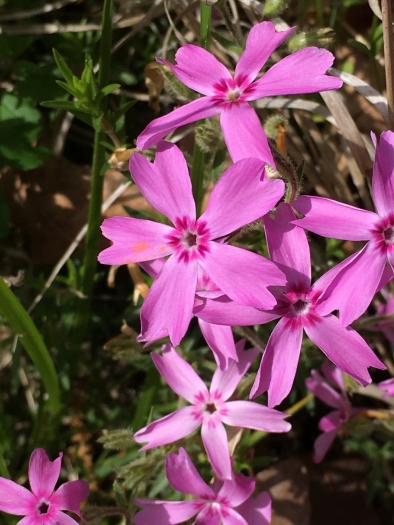Trailing Phlox
(Phlox nivalis)
Trailing Phlox (Phlox nivalis)
/
/

By Becky Dill no rights reserved
Public Domain
Image By:
By Becky Dill no rights reserved
Recorded By:
Copyright:
Public Domain
Copyright Notice:
Photo by: By Becky Dill no rights reserved | License Type: Public Domain | License URL: http://creativecommons.org/publicdomain/zero/1.0/ | Uploader: gillydilly | Publisher: iNaturalist |




















































Estimated Native Range
Summary
Phlox nivalis, commonly known as Trailing Phlox, is an evergreen perennial subshrub or herb native to open woodlands and sandy areas in the Southeastern USA, particularly in pine barrens and on slopes. It typically has semi-woody, thin, stiff, needle-like stems and a prostrate, low-lying form. The plant grows low to the ground, forming mounds that spread along the ground. Its flowers, which bloom in the spring months, have five radially symmetric petals with spreading lobes and a narrow floral tube. The flowers range in color from shades of purple and pink to white, with vibrant colors at the petal ends and darker coloration in the tubes or centers, making them quite showy.
Trailing Phlox is valued for its drought tolerance and ability to provide early spring color. It is commonly used to border walkways or paths and is also popular in hanging baskets or containers due to its cascading habit. The plant is known to attract hummingbirds, adding to its appeal in garden settings. While it prefers acidic, loamy, and sandy soils for quick drainage, it is adaptable to various soil types if they are well-drained. In cultivation, it thrives in full sun to part shade and requires low to medium amounts of water. Gardeners should be aware that while Phlox nivalis is generally disease-resistant, it can suffer from powdery mildew in humid conditions.CC BY-SA 4.0
Trailing Phlox is valued for its drought tolerance and ability to provide early spring color. It is commonly used to border walkways or paths and is also popular in hanging baskets or containers due to its cascading habit. The plant is known to attract hummingbirds, adding to its appeal in garden settings. While it prefers acidic, loamy, and sandy soils for quick drainage, it is adaptable to various soil types if they are well-drained. In cultivation, it thrives in full sun to part shade and requires low to medium amounts of water. Gardeners should be aware that while Phlox nivalis is generally disease-resistant, it can suffer from powdery mildew in humid conditions.CC BY-SA 4.0
Plant Description
- Plant Type: Subshrub, Herb
- Height: 0.5-0.7 feet
- Width: 1-1.3 feet
- Growth Rate: Moderate
- Flower Color: Pink, Purple, White
- Flowering Season: Spring, Summer
- Leaf Retention: Evergreen
Growth Requirements
- Sun: Full Sun, Part Shade
- Water: Medium
- Drainage: Slow, Medium
Common Uses
Bank Stabilization, Bee Garden, Bird Garden, Border Plant, Butterfly Garden, Drought Tolerant, Fragrant, Groundcover, Hummingbird Garden, Low Maintenance, Potted Plant, Showy Flowers
Natural Habitat
Native to open woodlands and sandy areas, particularly pine barrens and slopes
Other Names
Common Names: Pineland Phlox, Pine Phlox, Sweet Trailing
Scientific Names: , Phlox nivalis, Phlox nivalis var. nivalis, Phlox nivalis f. nivalis,
GBIF Accepted Name: Phlox nivalis Lodd.